The Birth of Top 40 Radio
|
Todd Storz and KOWH
Omaha
|
|
Robert Todd Storz is commonly credited with inventing
the Top 40 Radio format in the early 50's when he owned
KOWH, an Omaha radio station. The story goes that while
sitting with an employee at a diner near his station, he
noticed that the waitresses kept playing the same
popular songs over and over on the jukebox each time
they got a tip. Figuring that this observation might
give KOWH a bit of an advantage in attracting listeners,
he implemented a new music format of just the hits, over
and over.. |
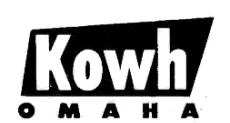 |
In 1949, Todd Storz
purchased a daytime station in Omaha, Nebraska. At the
time, block programs and network entertainment shows
were the norm for successful radio and music was a fill
or part of a variety show.
The use of recorded music on the radio was
severely restricted by the American Federation of
Musicians. But the control of the AFM declined rapidly as the 50's
began, and requirements to have station musicians was
soon eliminated.
The background is sometimes fuzzy, with different
and highly anecdotal story
lines, but the fact is clear that KOWH was
the first station to base its programming exclusively on
the top hits of the moment, with no other programming
breaking up the constant rotation of the same few dozen
songs. |
Before...
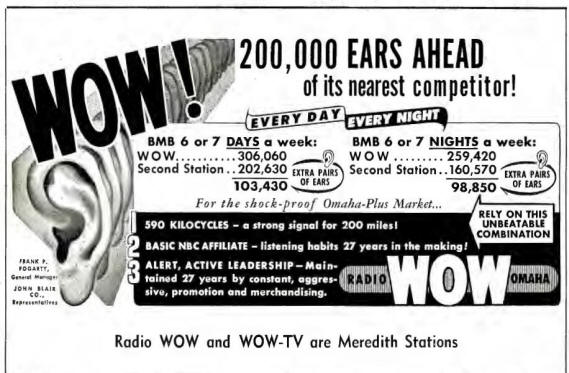
In 1951, the leader was WOW, followed by KFAB. This ad
from the Broadcasting Yearbook from the edition prior to
the debut of KOWH as a Top 40 station shows how the
market looked "before Top 40."
|
... and After.
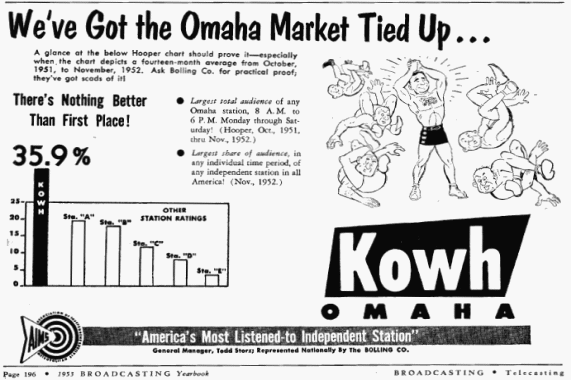
Here is an ad from the next year's edition of the
Yearbook with KOWH taking the crown for most listening.
Not only was this an amazing feat, it is all the more
interesting because KOWH only operated from sunrise to
sunset. Those WOW "Listening habits 27 years in the
making" fell in just months.
|
And even later...
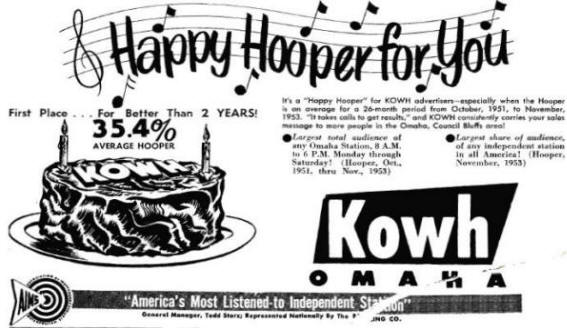
The ratings continued to hold for another year. This is
from the 1954 Broadcasting Yearbook edition.
|
Some say that Storz commissioned a study
about radio listening habits with a local
university, others say that he saw an already finished
study. But the supposed study, whoever paid for it,
reportedly said that
people, at the dawn of the television era, listened to the radio in their majority to hear
music.
Yet others say there was no such study. They say that
the idea for Top 40 was generated by watching people
select songs at a diner.
Whatever the inspiration might have been,
Storz' own anecdotal experience showed that people liked
to hear the same "big songs" over and over. One version
of that experience has him observing juke box play and
noting that the same few songs got most of the play.
The facts are that Todd Storz came up with the idea of
playing the same songs, all day long, with no other
programs, features or interruptions.
Your webmaster for this site was 18 in 1964 and was
building South America's first Top 40 station in Quito,
Ecuador. On an April 10 layover in Miami when returning from an
equipment buying trip, I visited WQAM and was introduced
to Todd Storz. He gave me several hours of friendly
instruction in how to do Top 40 right; what he told me
worked and my station debuted at #1. So in my mind,
there is no question about Mr. Storz' authenticity,
knowledge and genius.
Todd Storz died of a stroke just two days after I met
him.
|

Click to read the Television Magazine article about
Storz and his stations
May, 1957
|
Richard Fatherly, who passed in
2011, worked with Todd Storz. He later produced several
narratives about the Storz stations. In correspondence, Mr. Fatherly
furthered my anecdotal knowledge of the Storz story and
provided me with the following MP3 audio files.
Click:
Richard Fatherly's documents.
The audio segments are streamable by clicking any of
these:
Click:
The Todd Storz Revolution - Radio's Happiest
Broadcasters #1
Click:
The Todd Storz Revolution - Radio's Happiest
Broadcasters #2
Click:
The Todd Storz Revolution - Radio's Happiest
Broadcasters #3
Click:
The Todd Storz Revolution - Radio's Happiest
Broadcasters #4
Click:
The 1958 DJ Convention
Click:
The Radio Revolution
|
So,
at some moment in or around
about August of 1951 KOWH became the first all current
hits station.
Among the early Top 40 stations was KLIF in Dallas,
where Gordon McLendon launched his own broadcast empire.
|
|
KOWH
Advertisements |
Rather than narrate the much discussed creative
process behind KOWH, I thought it would be more
interesting to show what happened after the format made
it through its first ratings book. Here are some of the early ads...
starting in February, 1953 just
a month after the first full year of ratings was
released.
A series of similarly themed ads followed, and here are
some from 1952 to 1955. Click on any of them to
see a larger version. There are "hidden" mouse-over
forward and back arrows on the right and left that are
activated by mousing over them. |
| |
By 1954, WTIX in New
Orleans and WHB in Kansas City had been added but the
theme was the same.
|
| There are many more ads
and they later feature additional stations like WQAM,
KXOK and
WDGY and KOMA that were added to the group. The search feature of this website
will find many references to Todd Storz. Here is
a link to a search that will give you several hundred
KOWH references. Click on the picture of Mr. Storz to
see them. |
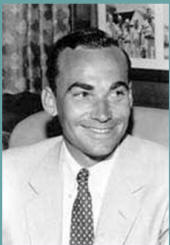
|
| Or, if you want to
search for the other stations, click the magnifying
glass below to go to the Broadcasting
Magazine search page and enter search terms like "Storz"
or "WQAM" to read further about what started the rebirth
of radio. I'd suggest limiting the search to the 50's
or even to 1951, 1952, 1953 and 1954 to
reduce the quantity of links you will generate. You may
also want to search other magazines on the site such as
Sponsor, Radio Daily, and USA Radio |
 |